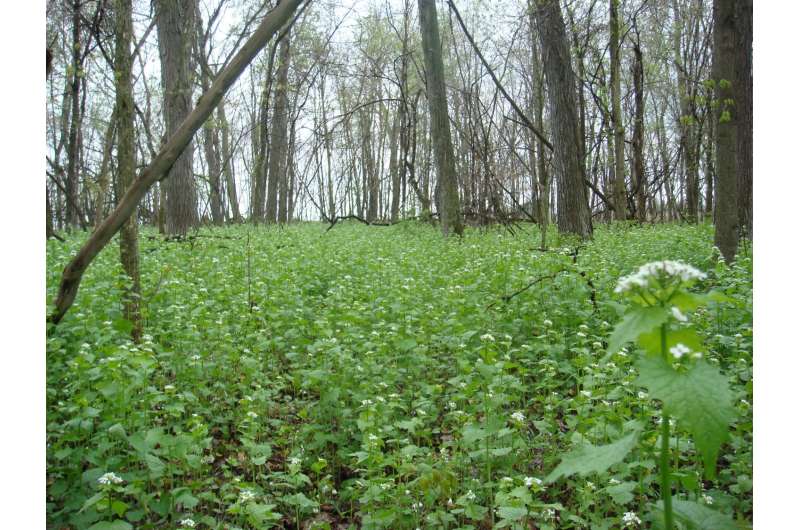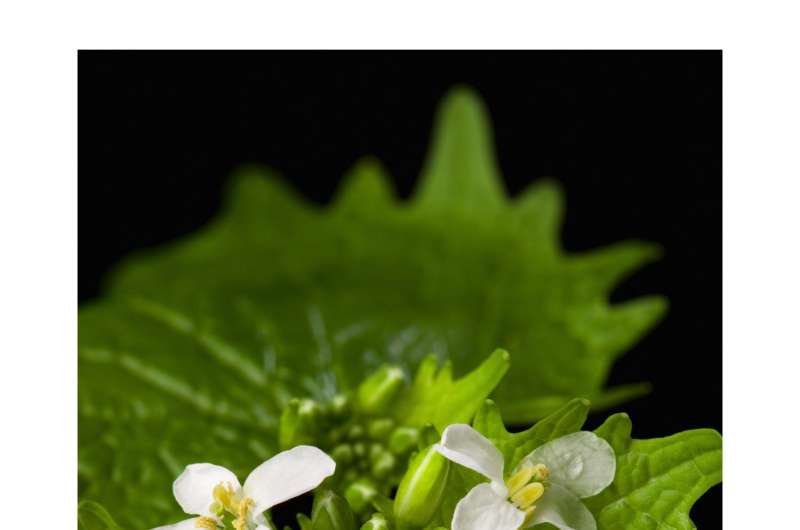Garlic mustard populations likely to decline

Invasive plants are often characterized as highly aggressive, possessing the power to alter and even irreversibly change the ecosystems they invade. But a recent University of Illinois study shows that one such invader, garlic mustard (Alliaria petiolata), actually becomes less aggressive over time.
"One of the things we've seen over the last 20 to 30 years is that garlic mustard becomes less of an issue, and actually balances out over time," says University of Illinois and USDA Agricultural Research Service ecologist Adam Davis.
When garlic mustard arrives in a new location, it releases a chemical known as sinigrin into the soil. Sinigrin is toxic to other plants and to the mycorrhizal fungi community, which other plants depend on to facilitate uptake of certain nutrients and water. Without their fungal partners, and through direct competition with growing garlic mustard populations for physical space, native plants quickly die out.
But when a garlic mustard population has been around for awhile, it produces less sinigrin.
"There's a fitness cost to producing sinigrin. So, when the native competitors drop out, it makes sense for garlic mustard to slow its production of this chemical," Davis explains.
In demonstrating the relationship between competition, an ecological phenomenon, and sinigrin production, an evolutionary phenomenon, the research team provided the first empirical example of a negative evolutionary feedback on an invasive species. That is, as garlic mustard populations become larger and more dense as a result of their superior competitive advantage, natural selection begins to act against the very mechanism that allowed for their initial success.

"Even though you might expect ecological processes to influence genetic and evolutionary ones, it has been shown very few times. It's an unusual thing to quantify, and, as far as we know, negative feedbacks haven't been demonstrated for other invaders," Davis says.
If garlic mustard becomes less aggressive over time, should landowners just leave it alone? Davis doesn't recommend a completely hands-off approach, but thinks landowners and managers should take a more holistic view of the ecosystems that garlic mustard invades.
"It may be satisfying to pull garlic mustard, but the damage you're doing to the herb layer by trampling it or by hosing it down with a chemical is probably worse than the garlic mustard itself. The main thing that creates space for garlic mustard is repeated disturbance. Landowners should try to minimize those disturbances and promote a healthy forest without micromanaging it," Davis suggests.
It might take decades to see garlic mustard fade out after its initial invasion, but Davis thinks there's reason to believe it will happen. "Ultimately," he says, "our results tell us we should have some faith in the ability of the ecosystem to achieve a new balance."
The article, "Evolutionary feedbacks on the ecology of the invasive plant Alliaria petiolata," is published in Functional Ecology.
More information: Jeffrey A. Evans et al, Soil-mediated eco-evolutionary feedbacks in the invasive plant, Functional Ecology (2016). DOI: 10.1111/1365-2435.12685
Journal information: Functional Ecology
Provided by University of Illinois at Urbana-Champaign
















